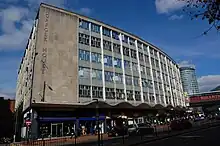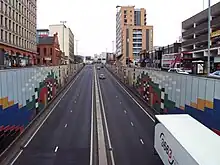Queensway, Birmingham
Queensway is the name of a number of roads in central Birmingham, England. The name most often refers to the Queensway tunnel, part of the A38.[1][2] However the name is also used as a suffix of several other roads and circuses, such as Smallbrook Queensway and Colmore Circus Queensway; all of these were once part of the historic A4400 Inner Ring Road, which was often called collectively the Queensway.

The Inner Ring Road (i.e. the Queensways) were built as dual carriageway major roads in the 1960s and 1970s. Junctions on the road were largely grade separated, with pedestrians kept physically separate from vehicular traffic and most junctions allowing vehicles staying on the road to pass over or under those using the junction. It is now widely regarded as one of the classic urban planning blunders of the 20th century.[3][4] Although seen as a revolutionary improvement when the first section opened in 1960, the 'Concrete Collar', as it became known, was viewed by council planners as an impenetrable barrier for the expansion of the city centre. In particular, it became unpopular with pedestrians who were required to use subways at the roundabouts.[5] According to the Birmingham Big City Plan published in 2011, the Ring Road has restricted open spaces, growth and economic activity. It has also made the city centre more crowded and harder to navigate.[6][7]
After 1988, the city council sought to recreate links between the city centre and the neighbouring areas, enlarging the city centre and improving the pedestrian environment across the city, with an emphasis on shifting vehicular movements out to The Middleway.[8] The Inner Ring Road was effectively dismantled by the 2000s - many roads have been rebuilt and downgraded and now far more resemble city streets.[9]
History
It was first planned by Herbert Manzoni in 1943 and an Act of Parliament permitting construction was passed in 1946. Due to financial controls, the first part of the ring road, Smallbrook Queensway, did not begin construction until 1957 and was completed in 1960. The entire ring road was opened by Elizabeth II on 7 April 1971. The Queen mistakenly named the entire ring road as Queensway during her speech, instead of just the one tunnel that was named Queensway. As a result of her gaffe, the entire ring road became officially known as Queensway.[10]

.jpg.webp)
Starting in the 1990s, some of Queensway has been altered in order to reverse the earlier strict separation of road and pedestrian traffic with a view to providing a more attractive environment for pedestrians, deter through traffic, and reducing the severance effects of the Inner Ring Road. For example, the pedestrian subway between Hurst Street and Hill Street was removed in 1993.[11] The Masshouse Circus was demolished in 2002.[12] In early 2008, the St Chads Queensway area near the St. Chad's Cathedral was modified to remove pedestrian underpasses and bring all pedestrian and car traffic back on to the traditional street level.

.jpg.webp)
These redevelopments were championed by the city council as breaking the 'concrete collar' around the city centre (especially in the Masshouse area), with the aim of making the city more friendly to pedestrian navigation, and improving the aesthetic appearance of the city.[13] Some motorists, however, bemoan the reduction of road capacity and point to the regular congestion on the remodelled sections. Controversially,[14] pedestrian crossings are replacing underpasses.[15] The A4400 still exists as the surface level road where the A38 runs in tunnels.
List of roads of the old ring road
The road previously consisted of the following roads (anticlockwise from A38(M) approach (Aston Expressway):
- St Chads Queensway (now A38)
- Lancaster Street Queensway
- St Chads Circus Queensway
- Paradise Circus Queensway, below Birmingham Central Library (now A38)
- Great Charles Queensway (now A38)
- Suffolk Street Queensway (now A38)
- Holloway Circus Queensway (now A38)
- Smallbrook Queensway (unclassified)
- St Martin's Queensway (demolished to make way for new Bullring development)
- Moor Street Queensway (now B4100) rebuilt into "Bus mall" renamed Moor Street Ringway
- James Watt Queensway (now B4114)
- Masshouse Circus Queensway, formerly roundabout over James Watt Queensway (demolished).
References
- "The history behind Birmingham's St Chad's and Queensway tunnels". BBC News. 20 July 2013. Retrieved 4 April 2023.
- Cardwell, Mark (5 October 2021). "Cars could be blocked from A38 Queensway tunnel - permanently". BirminghamLive. Retrieved 4 April 2023.
- Dale, Paul (7 August 2008). "Council blunder reveals Paradise Circus secret". Birmingham Post. Archived from the original on 12 October 2008. Retrieved 25 January 2010.
- Bayley, Stephen (29 June 2008). "It's all change in the second city... again". London: The Guardian. Retrieved 25 January 2010.
- "Birmingham tunnels: 'A plaster on a festering wound'". BBC News. 22 July 2013. Retrieved 4 April 2023.
- "Big City Plan Part 1" (PDF).
- "Big City Plan Part 2" (PDF).
- "Restructuring Birmingham's Inner Ring Road". Urban Design Compendium. Archived from the original on 16 December 2010. Retrieved 25 January 2010.
- "The Core, Big City Plan". Birmingham City Council. 31 March 2009. Archived from the original on 18 March 2009. Retrieved 31 March 2009.
- Mullen, Enda (2 August 2013). "Legend of the Queen giving Birmingham's ring road the wrong name is confirmed". Business Live. Retrieved 4 April 2023.
- Admin. "Smallbrook Queensway | Birmingham | The Academy of Urbanism". Retrieved 4 April 2023.
- "Birmingham seeks celebrity to start demolition of Masshouse Circus". www.egi.co.uk. Retrieved 4 April 2023.
- "Connectivity, Big City Plan". Birmingham City Council. 31 March 2009. Archived from the original on 15 April 2009. Retrieved 31 March 2009.
- "Birmingham Big City Plan Leaflet Consultation". Birmingham City Council. Archived from the original on 16 October 2011. Retrieved 3 May 2011.
- "Masshouse Circus Redevelopment, Birmingham". Gifford, part of Ramboll UK Ltd. Archived from the original on 24 July 2011. Retrieved 3 May 2011.